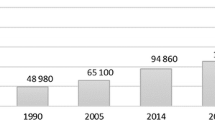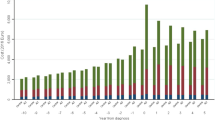Abstract
Objectives
The aim of this analysis was to determine the direct costs for patients with Alzheimer’s disease (AD) based on data supplied by a large German statutory health insurance (BARMER). Focus of the present evaluation is the exposure of total direct costs, survival rates and the types of care distribution of patients with AD.
Methods
The analysis was based on anonymised data of patients with Alzheimer’s disease who were insured by a large German statutory health insurance (Barmer Ersatzkasse-BEK) in 2005 over 12 months (n = 35.684). The study population was classified into three treatment groups: patients who received memantine and no other antidementia drugs, psychotropic drugs or sedatives/hypnotics (memantine group); patients who neither received memantine nor other antidementia drugs but psychotropic drugs and/or sedatives/hypnotics (PHS group); and patients who received no antidementia drugs and no psychotropic drugs or sedatives/hypnotics (no AT group). A Markov model was designed to assess the costs of each treatment group depending on the type of care over a 5-year period.
Results
The results obtained for the PHS group were the following: after 5 years, 25.1% were in inpatient health care, 1.1% in partial inpatient care, 5.4% in outpatient care, and 64.5% of patients died. Only 3.9% did not require care. On average, direct costs to the amount of 7.948 € incurred per patient and year and 13.099 € per surviving patient. In the group without pharmacotherapy, 20.6% were in inpatient care, 0.3% in partial inpatient care, 12.8% in outpatient care, and 52.5% of the patients died. For 13.8% of the patients, care was not necessary. The annual costs amounted to 6.760 € per patient and 9.926 € per surviving patient. The results obtained for the memantine group were more beneficial: annual costs per patient amounted to 6.100 € and to 8.376 € per surviving patient.
Conclusions
The results demonstrate that non-antidementive therapy for Alzheimer’s disease causes higher costs especially for care. The memantine group proved to be superior compared to PHS group and no AT group, despite higher costs in the specific drug category.



Similar content being viewed by others
References
Bickel, H.: Dementia syndrome and Alzheimer disease: an assessment of morbidity and annual incidence in Germany. Gesundheitswesen 62(4), 211–218 (2000)
Bickel, H.: Dementia in advanced age: estimating incidence and health care costs. Z. Gerontol. Geriatr. 34(2), 108–115 (2001)
Jakob, A., Busse, A., Riedel-Heller, S.G., Pavlicek, M., Angermeyer, M.C.: Prevalence and incidence of dementia among nursing home residents and residents in homes for the aged in comparison to private homes. Z. Gerontol. Geriatr. 35(5), 474–481 (2002)
Vollmar, C., Koch, M., Löscher, S., Butzlaff, M.: Demenz-Evidenzbasierte Leitlinie zur Diagnose und Therapie 2005 [cited 2008 Aug 26]
Deutsche Gesellschaft für Psychiatrie, Psychotherapie und Nervenheilkunde. Behandlungsleitlinie Demenz. Kurzversion 2008 [cited 2008 Sep 9]
Statistisches Bundesamt. Gesundheit. Krankheitskosten 2002. Statistisches Bundesamt 2004, Wiesbaden. 2008
Specht-Leible, N., Bender, M., Oster, P.: Causes for in-hospital treatment of nursing home residents. Z. Gerontol. Geriatr. 36(4), 274–279 (2003)
Caro, J.J., Getsios, D., Migliaccio-Walle, K., Raggio, G., Ward, A.: Assessment of health economics in Alzheimer’s disease (AHEAD) based on need for full-time care. Neurology 57(6), 964–971 (2001)
Grassel, E., Donath, C., Lauterberg, J., Haag, C., Neubauer, S.: Dementia patients and levels of care: do symptoms of the illness affect the grading? Gesundheitswesen 70(3), 129–136 (2008)
Wimo, A., Winblad, B.: Health economic aspects of Alzheimer’s disease and its treatment. Psychogeriatrics (1), 189–193 (2001)
Wimo, A., Winblad, B., Stoffler, A., Wirth, Y., Mobius, H.J.: Resource utilisation and cost analysis of memantine in patients with moderate to severe Alzheimer’s disease. Pharmacoeconomics 21(5), 327–340 (2003)
Acknowledgments
The study was financially supported by Merz Pharmaceuticals, Germany.
Author information
Authors and Affiliations
Corresponding author
Rights and permissions
About this article
Cite this article
Kiencke, P., Daniel, D., Grimm, C. et al. Direct costs of Alzheimer’s disease in Germany. Eur J Health Econ 12, 533–539 (2011). https://doi.org/10.1007/s10198-010-0267-x
Received:
Accepted:
Published:
Issue Date:
DOI: https://doi.org/10.1007/s10198-010-0267-x




